Trend Analysis of Nitrate Concentration in Rivers in Southern France
Abstract
1. Introduction
2. Materials and Methods
2.1. Study Area
2.2. Water Quantity and Quality Monitoring Stations
2.3. Prediction of Nitrate Concentrations and Trend Analysis
2.3.1. Estimation of Water Quality Time Series Data
2.3.2. Trend Estimation
3. Results
3.1. Estimated Daily Flow-Weighted Nitrate Concentration Trends Using the WQ154 Dataset
3.2. Annual Nitrate Concentration Trends Using the WQ366 Dataset (Raw Data)
3.3. Annual Nitrate Concentration Trends Using WQ154
3.4. Impact of Flow and Management on Nitrate Trends
4. Discussion
5. Conclusions
Supplementary Materials
Author Contributions
Funding
Conflicts of Interest
References
- EEA European Environment Agency’s home page — European Environment Agency. Available online: https://www.eea.europa.eu/ (accessed on 1 September 2019).
- EC Council of the European Communities CEC, 1991. Council Directive 91/676/EEC Concerning the Protection of Waters against Pollution Caused by Nitrates from Agricultural Sources. Off. J. L 375. 1991. Available online: https://eur-lex.europa.eu/legal-content/EN/ALL/?uri=celex%3A31991L0676 (accessed on 1 September 2019).
- EC Report from the Commission to the Council and the European Parliament on the Implementation of Nitrates Directive Concerning the Protection of Waters against Pollution Caused by Nitrates from Agricultural Sources (Period 2012–2015). SWD (2018) 246 Final. EC Europa Eu. 2018. Available online: https://ec.europa.eu/environment/water/water-nitrates/pdf/nitrates_directive_implementation_report.pdf (accessed on 1 September 2019).
- Hirsch, R.M.; Slack, J.R.; Smith, R.A. Techniques of trend analysis for monthly water quality data. Water Resour. Res. 1982, 18, 107–121. [Google Scholar] [CrossRef]
- Helsel, D.R.; Hirsch, R.M. Geological Survey (Techniques of Water-Resources Investigations of the United States Geological Survey, Book 4, Hydrologic Analysis and Interpretation Chapter A3). In Statistical Methods in Water Resources U.S; OMS US EPA; USGS Publications Warehouse : Reston, VA, USA, 2002. Available online: https://pubs.er.usgs.gov/publication/twri04A3 (accessed on 1 September 2019).
- Esterby, S.R. Review of methods for the detection and estimation of trends with emphasis on water quality applications. Hydrol. Process. 1996, 10, 127–149. [Google Scholar] [CrossRef]
- Dupas, R.; Minaudo, C.; Gruau, G.; Ruiz, L.; Gascuel-Odoux, C. Multidecadal Trajectory of Riverine Nitrogen and Phosphorus Dynamics in Rural Catchments. Water Resour. Res. 2018, 54, 5327–5340. [Google Scholar] [CrossRef]
- Bouraoui, F.; Grizzetti, B. Modelling mitigation options to reduce diffuse nitrogen water pollution from agriculture. Sci. Total. Environ. 2014, 1267–1277. [Google Scholar] [CrossRef] [PubMed]
- Casal, L.; Durand, P.; Akkal-Corfini, N.; Benhamou, C.; Laurent, F.; Salmon-Monviola, J.; Ferrant, S.; Probst, A.; Probst, J.-L.; Vertès, F. Reduction of stream nitrate concentrations by land management in contrasted landscapes. Nutr. Cycl. Agroecosystems 2019, 114, 1–17. [Google Scholar] [CrossRef]
- Vero, S.; Basu, N.B.; Van Meter, K.J.; Richards, K.G.; Mellander, P.-E.; Healy, M.G.; Fenton, O. Review: The environmental status and implications of the nitrate time lag in Europe and North America. Hydrogeol. J. 2017, 26, 7–22. [Google Scholar] [CrossRef]
- Murphy, J.C.; Sprague, L.A. Water-quality trends in US rivers: Exploring effects from streamflow trends and changes in watershed management. Sci. Total. Environ. 2019, 656, 645–658. [Google Scholar] [CrossRef] [PubMed]
- Dupas, R.; Jomaa, S.; Musolff, A.; Borchardt, D.; Rode, M. Disentangling the influence of hydroclimatic patterns and agricultural management on river nitrate dynamics from sub-hourly to decadal time scales. Sci. Total. Environ. 2016, 571, 791–800. [Google Scholar] [CrossRef] [PubMed]
- Koenig, L.E.; Shattuck, M.D.; Snyder, L.E.; Potter, J.; McDowell, W.H. Deconstructing the Effects of Flow on DOC, Nitrate, and Major Ion Interactions Using a High-Frequency Aquatic Sensor Network. Water Resour. Res. 2017, 53, 10655–10673. [Google Scholar] [CrossRef]
- Moatar, F.; Abbott, B.W.; Minaudo, C.; Curie, F.; Pinay, G. Elemental properties, hydrology, and biology interact to shape concentration-discharge curves for carbon, nutrients, sediment, and major ions. Water Resour. Res. 2017, 53, 1270–1287. [Google Scholar] [CrossRef]
- Hirsch, R.M.; Moyer, D.L.; Archfield, S.A. Weighted Regressions on Time, Discharge, and Season (WRTDS), with an Application to Chesapeake Bay River Inputs1. JAWRA J. Am. Water Resour. Assoc. 2010, 46, 857–880. [Google Scholar] [CrossRef] [PubMed]
- Raymond, S.; Moatar, F.; Meybeck, M.; Bustillo, V. Choosing methods for estimating dissolved and particulate riverine fluxes from monthly sampling. Hydrol. Sci. J. 2013, 58, 1326–1339. [Google Scholar] [CrossRef]
- Stahl, K.; Hisdal, H.; Hannaford, J.; Tallaksen, L.M.; Van Lanen, H.A.J.; Sauquet, E.; DeMuth, S.; Fendekova, M.; Jódar, J. Streamflow trends in Europe: Evidence from a dataset of near-natural catchments. Hydrol. Earth Syst. Sci. 2010, 14, 2367–2382. [Google Scholar] [CrossRef]
- Agence de L’eau Adour-Garonne Water Quality Datasets. Available online: http://www.eau-adour-garonne.fr/fr/index.html (accessed on 1 September 2019).
- Agence de L’eau Rhône Méditerranée Corse Water Quality Datasets. Available online: https://www.eaurmc.fr/ (accessed on 1 September 2019).
- French Ministry of Environment. Bilan de la Mise en Oeuvre de la Directive Nitrates en France (données 2012–2015). Available online: https://www.eaufrance.fr/publications/bilan-de-la-mise-en-oeuvre-de-la-directive-nitrates-en-france-donnees-2012–2015 (accessed on 1 September 2019).
- Tockner, K.; Uehlinger, U.; Robinson, C.T. Rivers of Europe; Elsevier Ltd.: Amsterdam, The Netherlands, 2009; ISBN 9780123694492. [Google Scholar]
- EAUFRANCE HYDRO. Water Quantity Datasets. Available online: http://hydro.eaufrance.fr/ (accessed on 1 September 2019).
- Lehner, B.; Verdin, K.; Jarvis, A. New Global Hydrography Derived from Spaceborne Elevation Data. Eos 2008, 89, 93–94. [Google Scholar] [CrossRef]
- Hirsch, R.; De Cicco, L.; Watkins, D.; Carr, L.; Murphy, J. EGRET: Exploration and Graphics for RivEr Trends, Version 3.0.2. Available online: https://cran.r-project.org/package=EGRET (accessed on 5 May 2020).
- Tukey, J.W. Exploratory Data Analysis; Addison-Wesley: Reading, MA, USA, 1977. [Google Scholar]
- Choquette, A.; Hirsch, R.; Murphy, J.; Johnson, L.; Confesor, R. Tracking changes in nutrient delivery to western Lake Erie: Approaches to compensate for variability and trends in streamflow. J. Great Lakes Res. 2019, 45, 21–39. [Google Scholar] [CrossRef]
- Millard, S.P. EnvStats, an R Package for Environmental Statistics. Encyclopedia of Environmetrics 2013, 2. [Google Scholar] [CrossRef]
- Pettitt, A.N. A Non-Parametric Approach to the Change-Point Problem. J. R. Stat. Soc. Ser. C Applied Stat. 1979, 28, 126. [Google Scholar] [CrossRef]
- Nash, J.; Sutcliffe, J. River flow forecasting through conceptual models part I — A discussion of principles. J. Hydrol. 1970, 10, 282–290. [Google Scholar] [CrossRef]
- UNIFA French Regional Fertilisers Statistics. Available online: https://www.unifa.fr/ (accessed on 1 September 2019).
- Agreste Agreste, la Statistique Agricole. Available online: https://agreste.agriculture.gouv.fr/agreste-web/ (accessed on 1 September 2019).
- Whitmore, A.P.; Bradbury, N.; Johnson, P. Potential contribution of ploughed grassland to nitrate leaching. Agric. Ecosyst. Environ. 1992, 39, 221–233. [Google Scholar] [CrossRef]
- Van Geer, F.C.; Kronvang, B.; Broers, H.P. High-resolution monitoring of nutrients in groundwater and surface waters: Process understanding, quantification of loads and concentrations, and management applications. Hydrol. Earth Syst. Sci. 2016, 20, 3619–3629. [Google Scholar] [CrossRef]
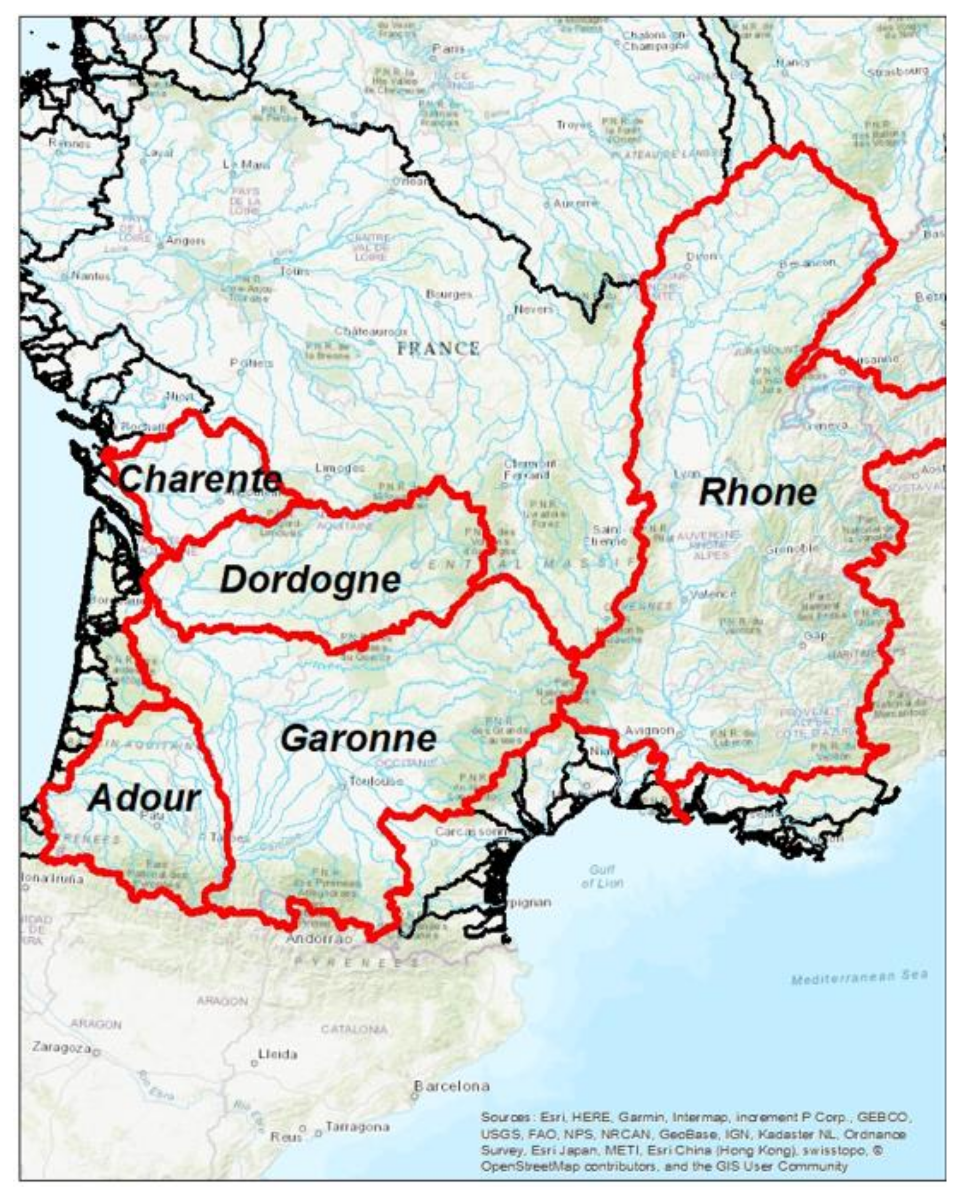
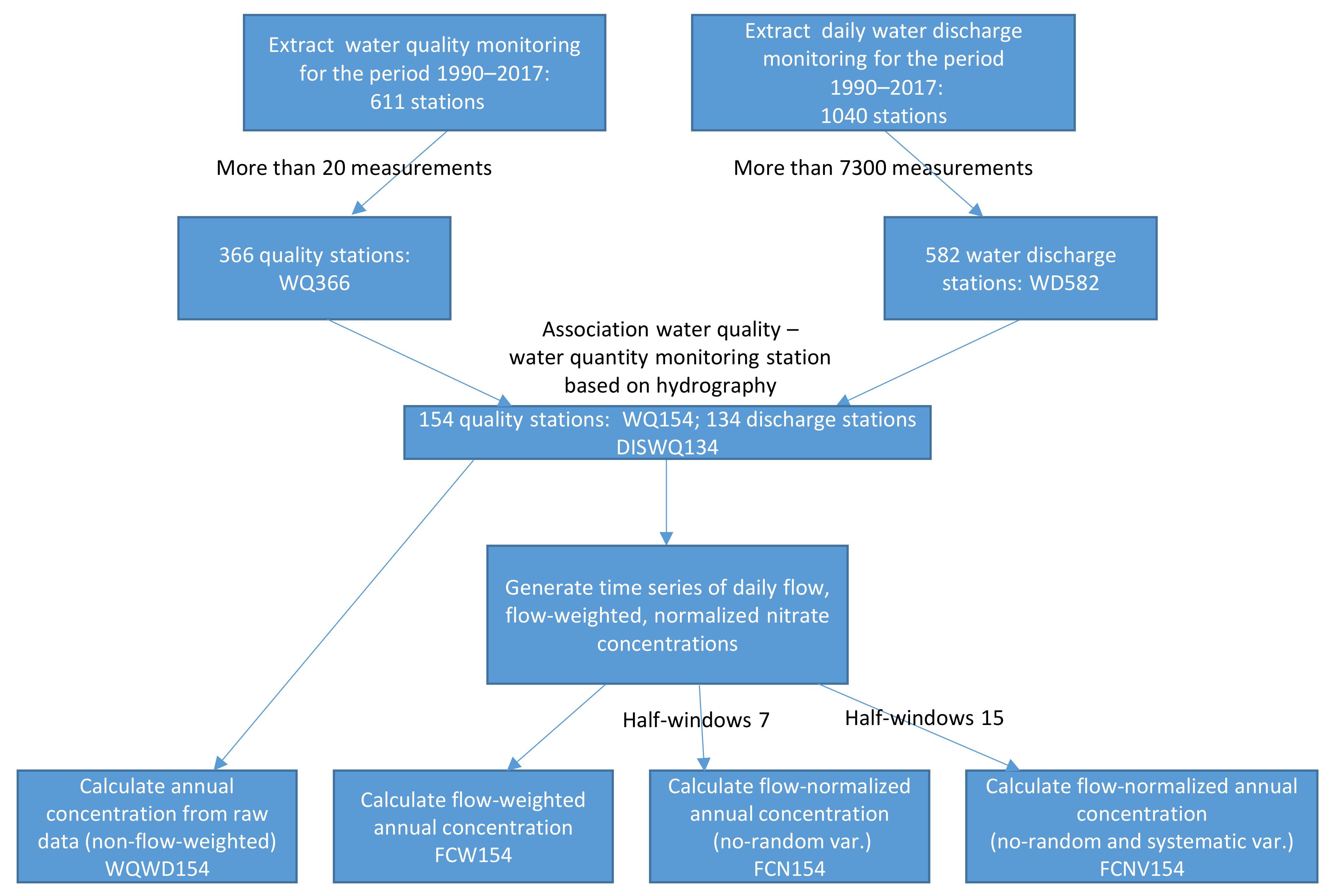
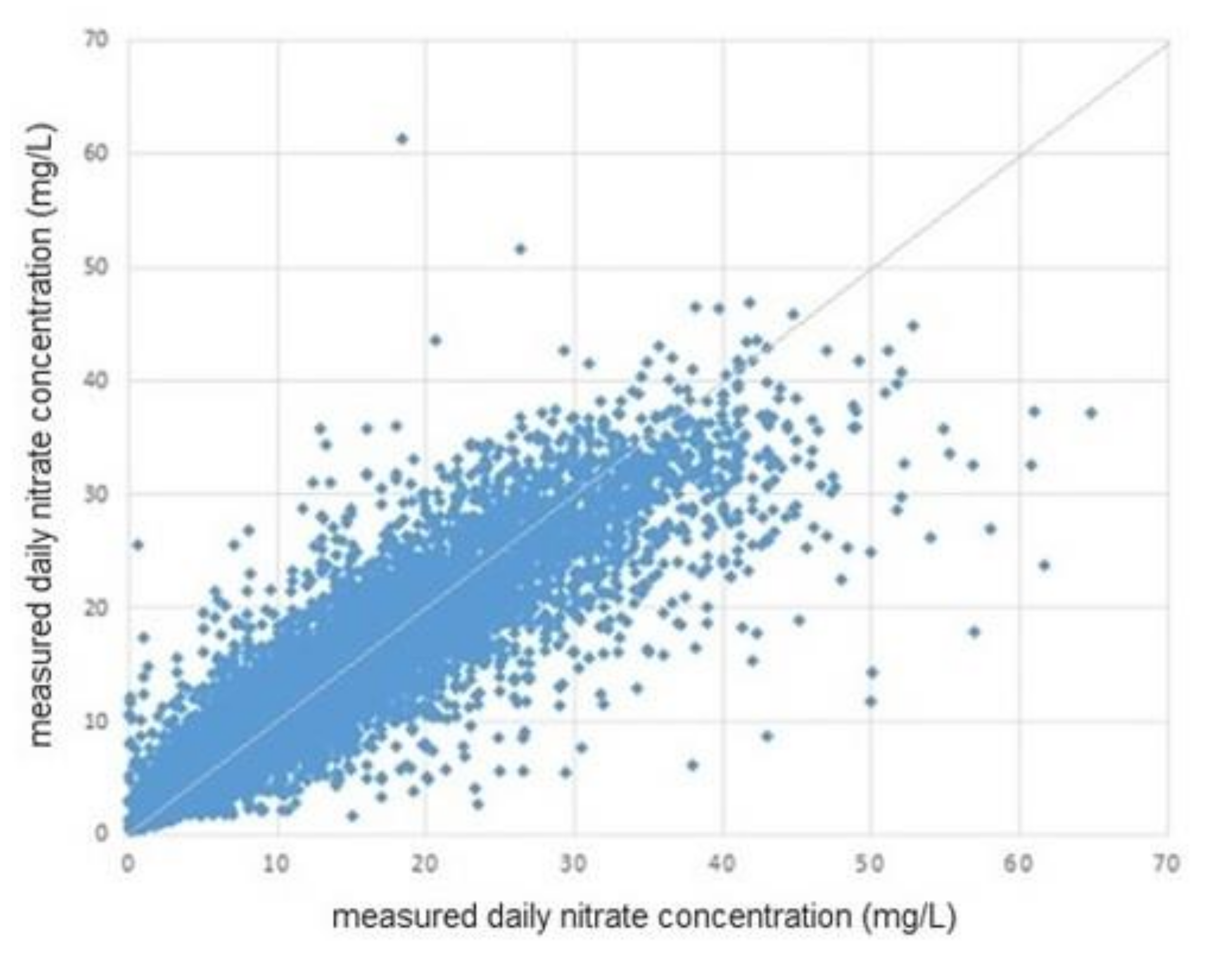
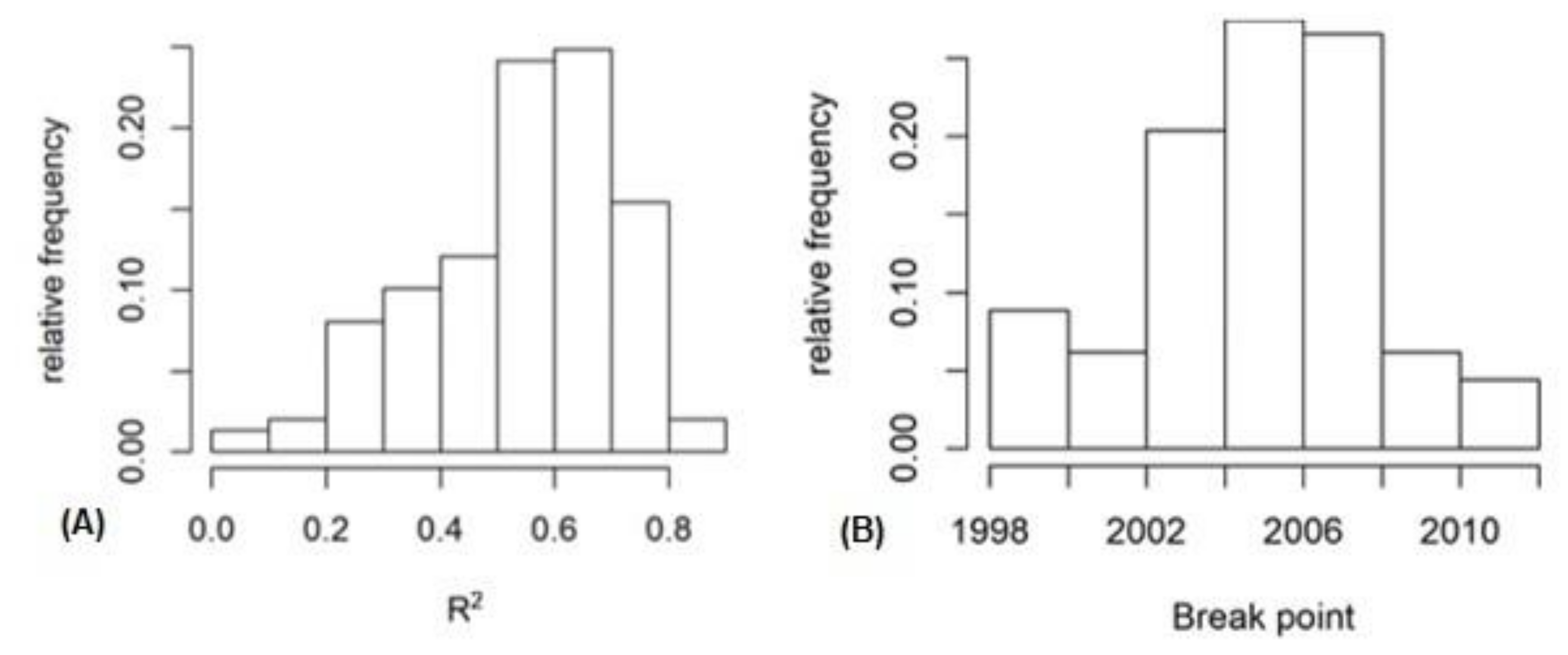
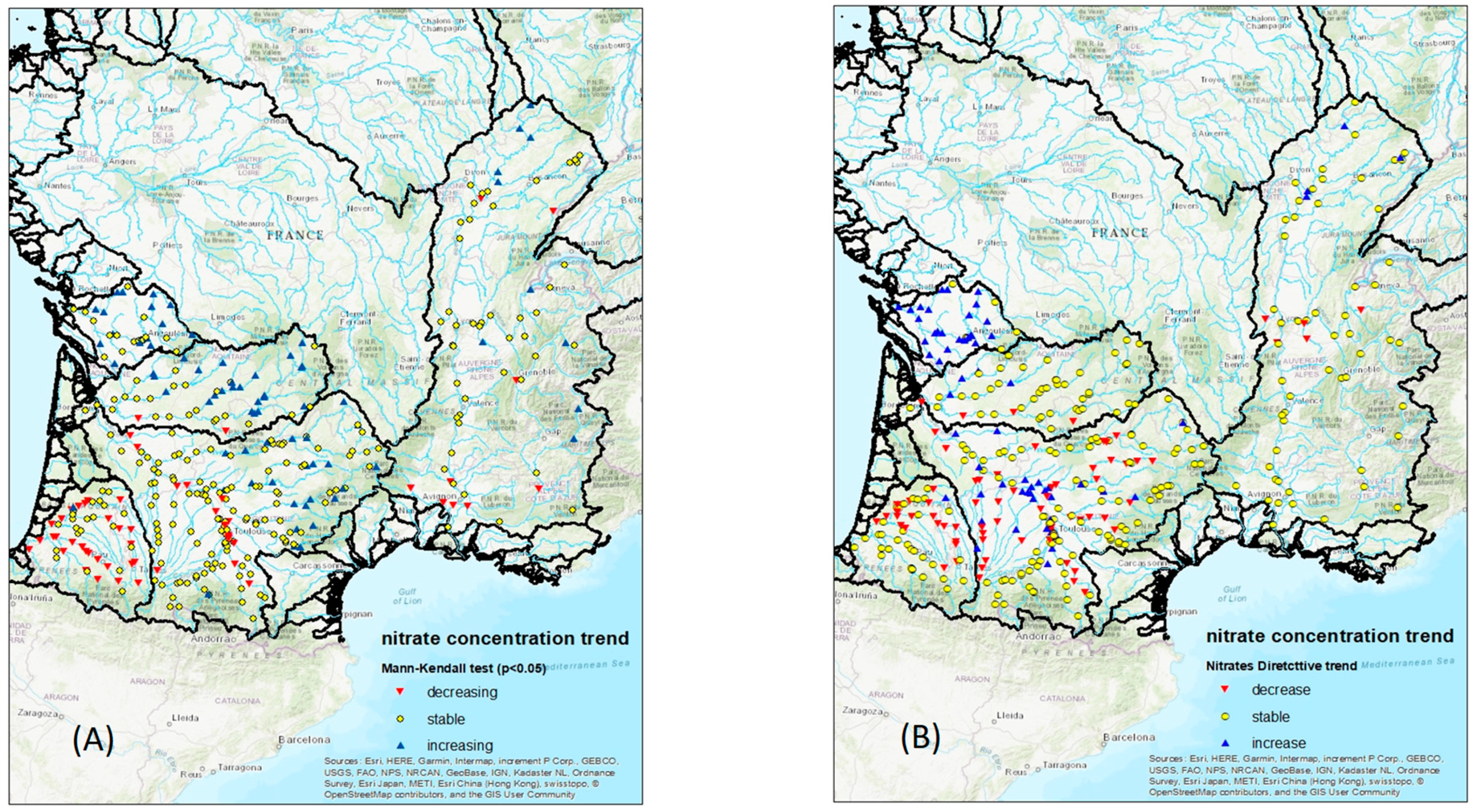
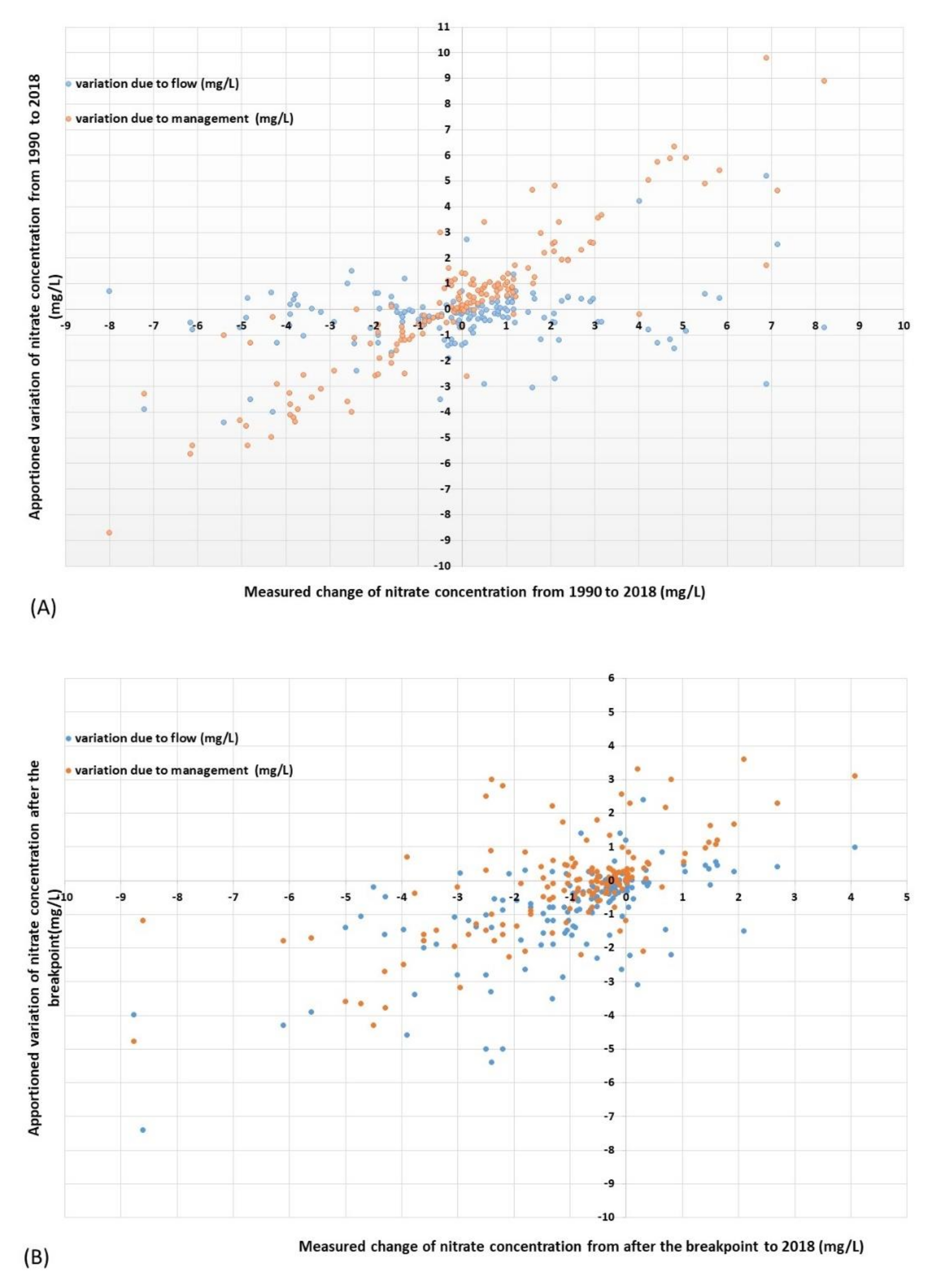
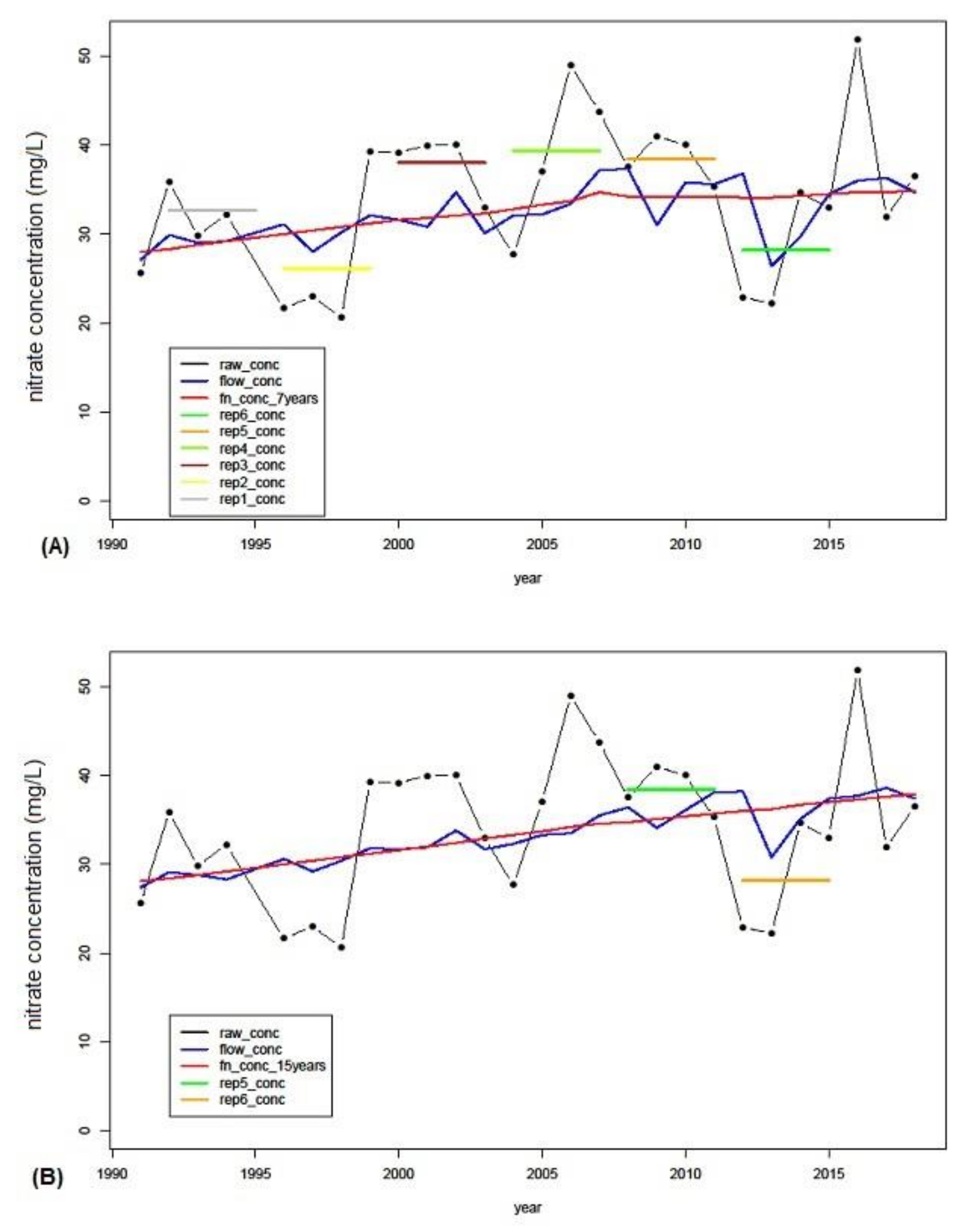
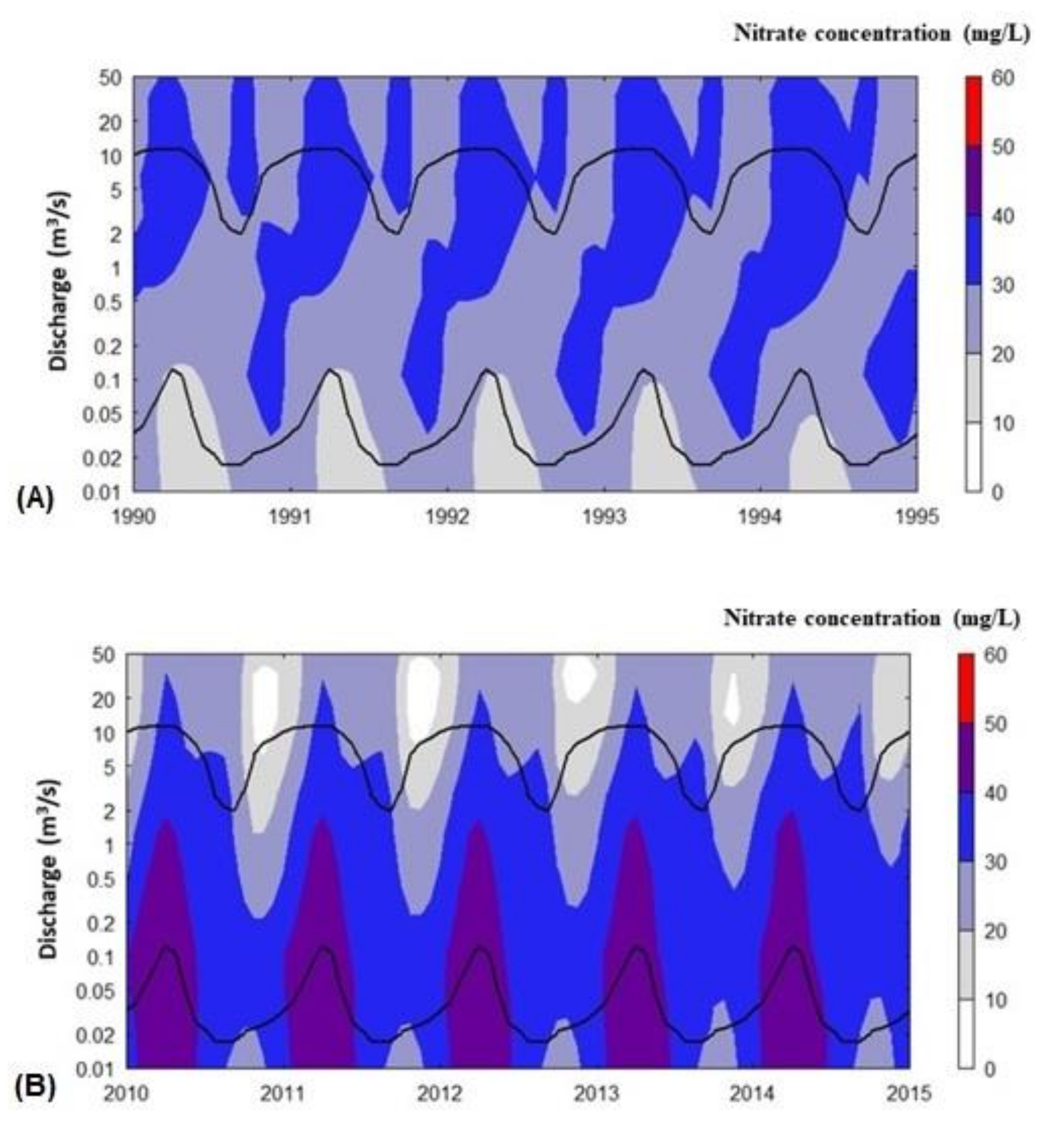
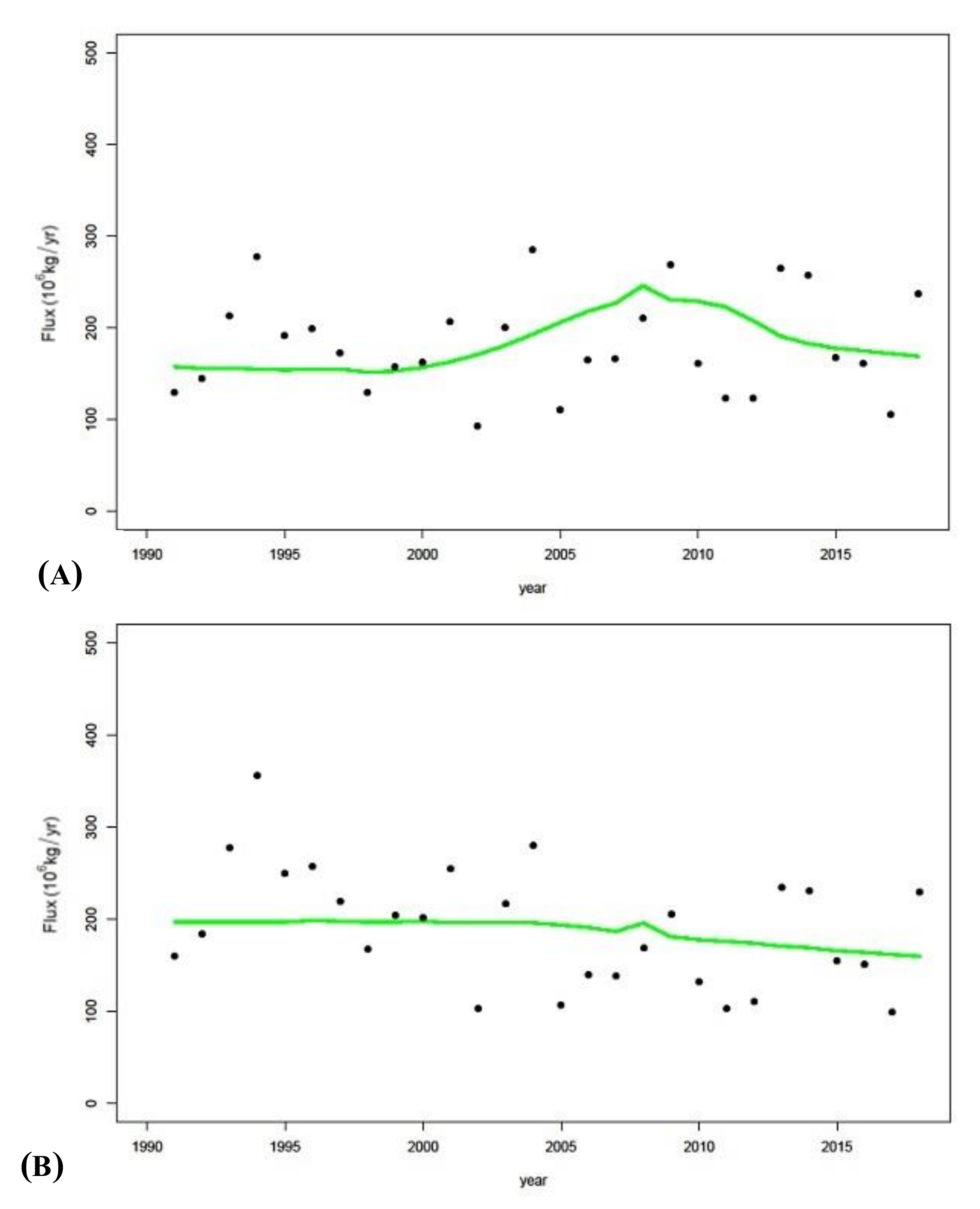
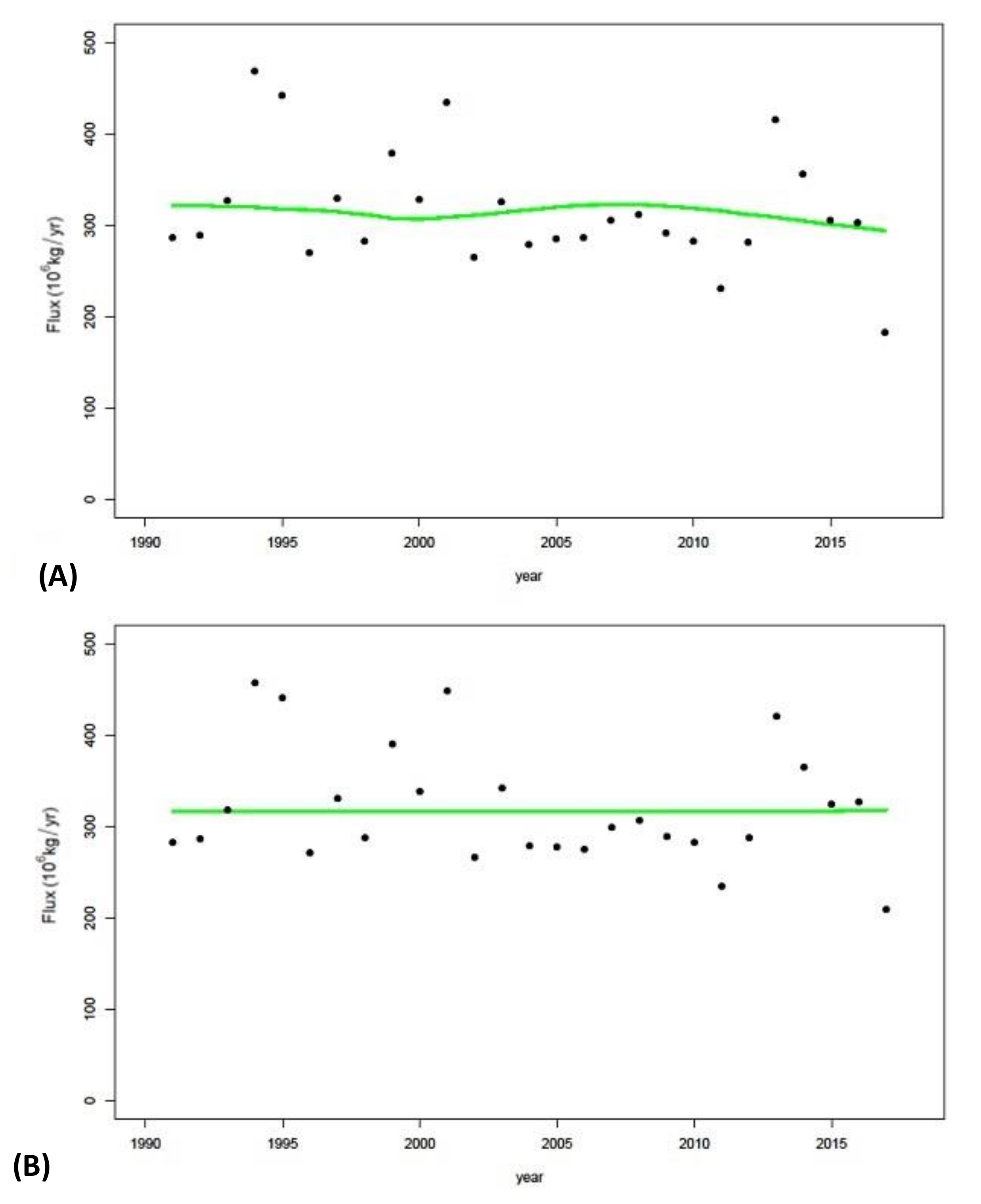
| Pressure/Impact | Rhone | Adour-Garonne | France | |
|---|---|---|---|---|
| Pressure (%) | Diffuse | 28 | 48 | 38 |
| Hydromorphology | 62 | 22 | 42 | |
| Point sources | 27 | 30 | 30 | |
| Impact (%) | Nutrient pollution | 21 | 55 | 33 |
| Adour | Charente | Dordogne | Garonne | Rhone | |
|---|---|---|---|---|---|
| Catchment area (103 km2) | 16.9 | 9.5 | 23.9 | 56.2 | 90.5 |
| Mean altitude (m) | 415 | 102 | 359 | 478 | 699 |
| Mean annual flow m3/s | 350 | 49 | 380 | 630 | 1700 |
| Arable land (%) | 39.5 | 68.6 | 46.6 | 34.4 | 30.1 |
| Population (106 inhabitant) | 1.1 | 0.5 | 1 | 4.1 | 8.9 |
| Nitrate Vulnerable Zone area (%) | 57 | 92 | 13 | 50 | 21 |
| Trend | Mann–Kendall | MSD Approach | ||
|---|---|---|---|---|
| Annual Maximum Concentration | Annual Minimum Concentration | Annual Mean Concentration | Annual Mean Concentration | |
| Decreasing trend (%) | 12 | 17 | 16 | 20 |
| No significant trend (%) | 70 | 68 | 64 | 63 |
| Increasing trend (%) | 18 | 15 | 20 | 17 |
| Trend | Mann–Kendall Test | MSD Trend | ||
|---|---|---|---|---|
| WQ154 (Raw Conc.) | FCW154 (Flow-Weighted Conc.) | FCN154 (Flow-Normalized Conc.) | FCW154 (Raw Conc.) | |
| Decreasing trend (%) | 13 | 34 | 34 | 19 |
| No significant trend (%) | 61 | 31 | 22 | 67 |
| Increasing trend (%) | 26 | 35 | 44 | 14 |
| Trend | Mann–Kendall Test | MSD Trend | ||
|---|---|---|---|---|
| WQ154 (Raw Conc.) | FCW154 (Flow-Weighted Conc.) | FCN154 (Flow-Normalized Conc.) | FCW154 (Raw Conc.) | |
| Decreasing trend (%) | 6 | 30 | 70 | 19 |
| No significant trend (%) | 93 | 66 | 20 | 67 |
| Increasing trend (%) | 1 | 4 | 10 | 14 |
| Trend | WQ154 (Raw Conc.) | FCW154 (Flow-Weighted Conc.) | FCN154 (Flow-Normalized Conc.) |
|---|---|---|---|
| Highly decreasing trend (%) | 3 | 0 | 16 |
| Decreasing trend (%) | 16 | 18 | 1 |
| No significant trend (%) | 67 | 80 | 82 |
| Increasing trend (%) | 11 | 2 | 1 |
| Highly increasing trend (%) | 3 | 0 | 0 |
| Station (%) | Trend Before Breakpoint | Trend After Breakpoint |
|---|---|---|
| 1 | ↔1 | ↔ |
| 8 | ↗2 | ↔ |
| 3 | ↔ | ↗ |
| 6 | ↗ | ↗ |
| 44 | ↗ | ↘3 |
| 8 | ↘ | ↔ |
| 10 | ↔ | ↘ |
| 4 | ↘ | ↗ |
| 16 | ↘ | ↘ |
| Trend | WQWD154 (Raw Concentration) | FCN154 (Flow-Normalized Concentration, Removing Random Variation of Flow) | FCNV154 (Flow-Normalized Concentration Removing Random and Systematic Variations of Flow) |
|---|---|---|---|
| Decreasing trend (%) | 13 | 34 | 38 |
| No significant trend (%) | 61 | 22 | 8 |
| Increasing trend (%) | 26 | 44 | 54 |
Publisher’s Note: MDPI stays neutral with regard to jurisdictional claims in published maps and institutional affiliations. |
© 2020 by the authors. Licensee MDPI, Basel, Switzerland. This article is an open access article distributed under the terms and conditions of the Creative Commons Attribution (CC BY) license (http://creativecommons.org/licenses/by/4.0/).
Share and Cite
Bouraoui, F.; Malagó, A. Trend Analysis of Nitrate Concentration in Rivers in Southern France. Water 2020, 12, 3374. https://doi.org/10.3390/w12123374
Bouraoui F, Malagó A. Trend Analysis of Nitrate Concentration in Rivers in Southern France. Water. 2020; 12(12):3374. https://doi.org/10.3390/w12123374
Chicago/Turabian StyleBouraoui, Fayçal, and Anna Malagó. 2020. "Trend Analysis of Nitrate Concentration in Rivers in Southern France" Water 12, no. 12: 3374. https://doi.org/10.3390/w12123374
APA StyleBouraoui, F., & Malagó, A. (2020). Trend Analysis of Nitrate Concentration in Rivers in Southern France. Water, 12(12), 3374. https://doi.org/10.3390/w12123374




